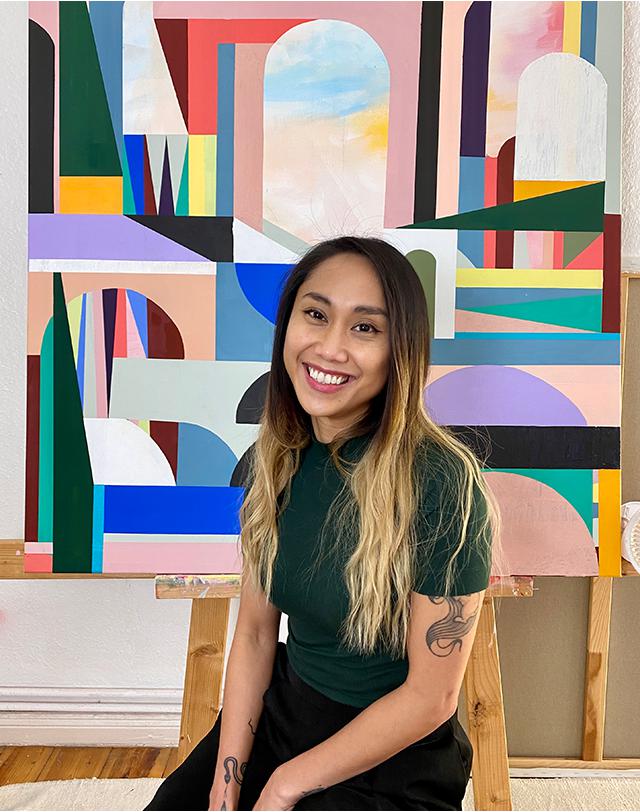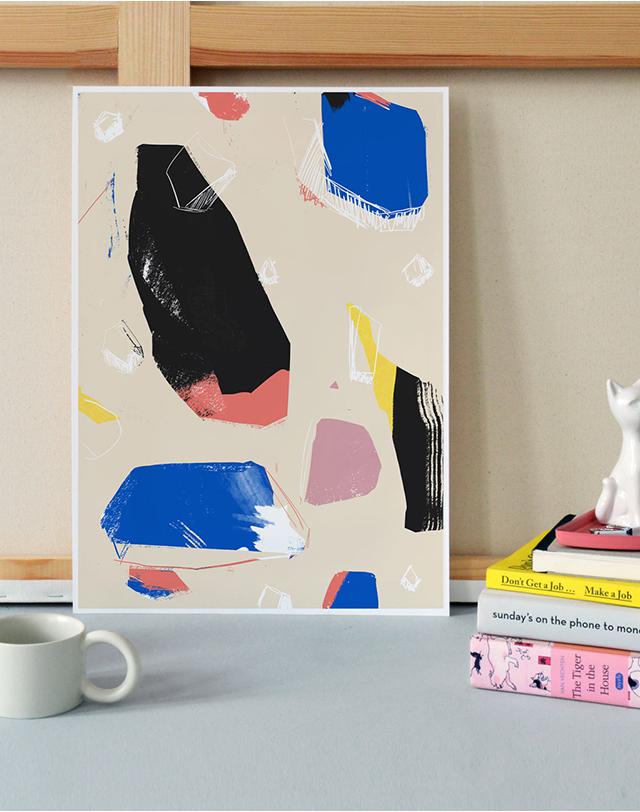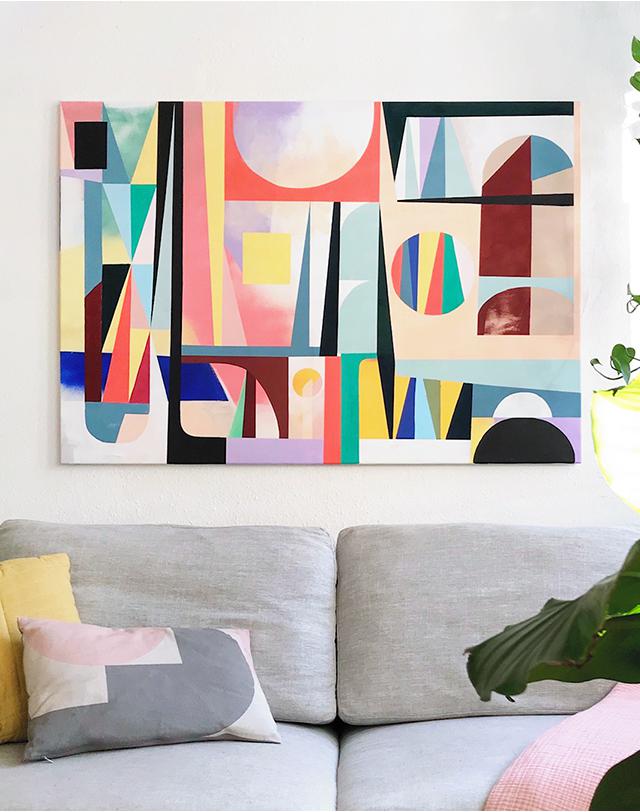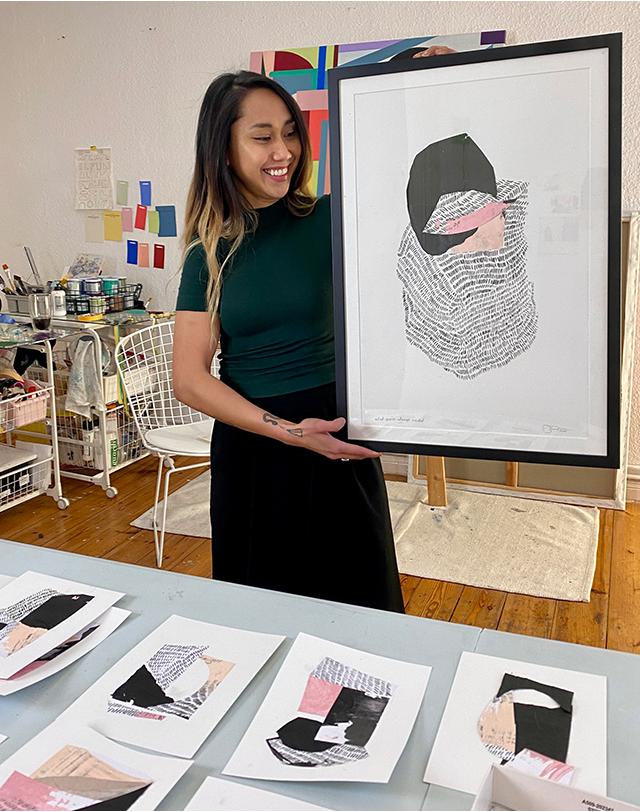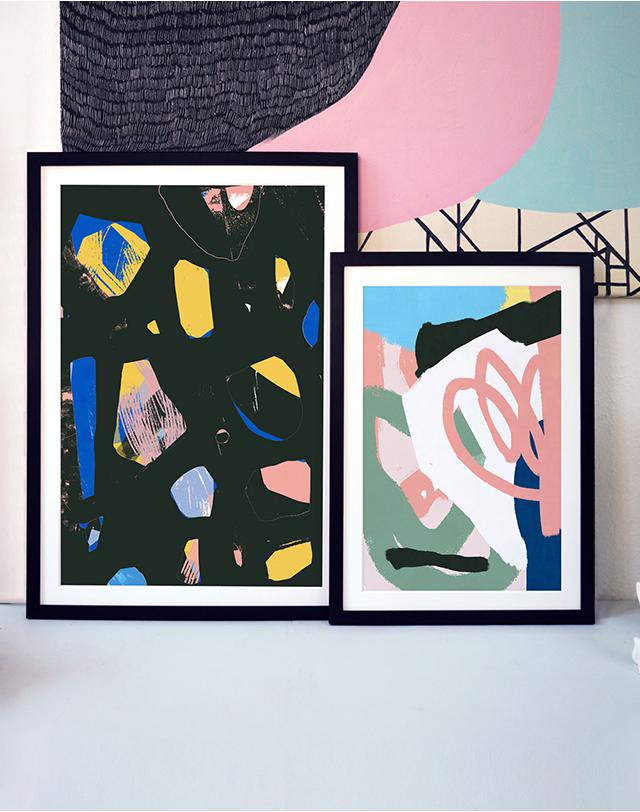Jill Castillo, or ‘Jilli’, as she’s known to her friends, has grown up around the world. Born in the Philippines, her father’s work as an engineer took the family to Saudi Arabia when she was nine, before moving them onwards to Toronto, where she spent most of her formative years. On finishing school, she followed her parents’ advice to become a graphic designer—working in Dublin, London, and Berlin—before finally biting the bullet and following her own dreams: to become an artist.
We speak over Zoom, her calling in from a white-walled, art-filled apartment. And she shows me Oly—the three-legged streetcat that she raised €500 for on a GoFundme page to adopt from Dubai—with one patron going so far as to offer to fly the cat over with her on the plane.
At home with Oly, Jill has what seems—at least from the outside—an easy-paced, stylishly bohemian life. She wakes up after a long sleep, puts the coffee on, and reads. “Mornings are for reflection”, she tells me. She then gets to work on her latest project.
Working across both digital and canvas, using acrylics and oil sticks, her style is bold, colourful, and abstract. She loves ‘Memphis’ design—an ‘80s movement which celebrates a combination of neon colours, textures and shapes—as well as the expressionist work of Helen Frankenthaler, one of the very first few women to paint with large, solid blocks of vibrant colours.
Jill also draws inspiration from her social media community, where she discovers the works of artists she might not otherwise have come across. “One of my favourites is Tom Abbiss Smith. His work just remains consistently graphically pleasing and beautiful. You can really see the work in it”, she says.
“I also love Polilovi or her portraits, for how simple and graphic they are, and how she did them from photographs of her portraits and then reduced it to make it look a little bit more graphic.”
When asked what it is that draws her to the abstract, minimalist forms she works with, she pauses.
“I think it’s something about the spaces within these blocks that feels like they could go on forever. I feel like you could dive in and just swim into it. It feels expansive in a way, regardless of whatever shape or form it is.”
It’s a style that lends itself to interpretation, and if you look closely enough, you can see glimmers of her past lives around the world between the forms. “My art is sort of like an escape from every day. There's a bit of surrealism that I feel with them, sort of like a vivid dream. A lot of it feels like daydreaming to me. All the boldness and all the colours. And sometimes, you can see a bit of sky or a gateway to something. It's definitely an escape.”
Of all the pieces that she works on, Jill most enjoys the challenges of the grander scales: “I love working as big as possible. And, I think those are always the ones I'm proudest of. I just feel so tiny with it, you know. And it's just the stark contrast of my dimensions. I wish I could work bigger, but they'll never make it out of the flat—or into it.”
In the background, one of her latest works stands on an easel. Bright colours, a mix of soft pinks and bright blues, jump out at you. A feast for the eyes, as your gaze is drawn to different corners of the canvas.
Asking about it, she tells me: “I try to use different colours, make different shapes, and break the grid. In design, typically there's a grid that your eyes kind of gravitate towards, with things aligning and kind of snapping onto. And it's easy for me to find a grid because I work with geometric shapes. But then to break out of the grid, I might insert some wonky shape in there, which I think visually looks more appealing. It puts interest somewhere, which you’ve then got to find a balance for. So visually speaking, it creates a dynamic and a certain flow, where the eye doesn't expect it.”
The picture has been spray painted, and layered with acrylics on top of an old picture that she was less pleased with. Something, which is in some way reflective of the artist sitting in front of me.
On the one hand, she’s exuberant, extroverted, lively. But at the same time, she is contemplative, meditative, and thoughtful. This comes out through her work, in the form of two contrasting styles—the bigger, extrovert paintings, and then the minimalist studies, and her drawings, for her more introverted side.
In many ways, working on art is like meditating. Jill zones into it, and lets everything else simply fall away: “I call the studies and the drawings my meditation work. I'm not trying to put shapes together that work well, or to put colours together that have an even contrast. It's very automatic, just making marks, leaving splotches, those kinds of things. I’m meditating through it. Sometimes, my mind will wander into stuff deep down, at the back of the head. But then the act of making also diffuses that.”
But more than that, art has been healing at times, and has moved her through difficult parts of her life: “I really have to attest to the hard times. Pushing through that is really where you come out the strongest, so that you're that much closer to who you are, and where you're supposed to be. I personally would say, it wasn't until a series of burnouts that I really went through this realisation—amidst a depression and amidst a lot of personal struggles, professionally and personally. And I realised that this may have been a symptom of not really listening to myself, and who I was, and what I wanted to do, which I then slowly discovered by turning towards art.
“I guess the beauty of following your dreams is just that when you're doing something that is really inherently you and it's coming from your soul, pieces will fit. It's not easy work. It's never going to be easy. But I think the closer you are and the truer to yourself you are, things tend to kind of happen that much more. The magic kind of comes together, piece by piece.”
For more of Jilli’s work, see her full collection here and follow her on Instagram @jillidarlingart.
Text: Anna Fleck
